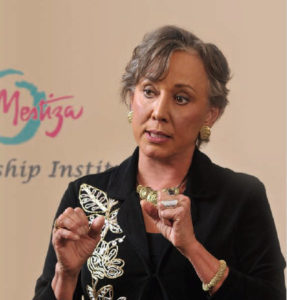
Latinos are Turning 40!
By Juana Bordas
 Many people do not know that until the 1970 census there was no group identified as Hispanic or Latino! Filling out my first census in 1960, I looked for a category that acknowledged ancestry. I felt a thud in my heart as I checked the Caucasian box and heard my sweet grandmother’s voice, “Never forget where you came from.” But remembering your history and embracing your identity is difficult when there is no acknowledgement that you people even exist.
Many people do not know that until the 1970 census there was no group identified as Hispanic or Latino! Filling out my first census in 1960, I looked for a category that acknowledged ancestry. I felt a thud in my heart as I checked the Caucasian box and heard my sweet grandmother’s voice, “Never forget where you came from.” But remembering your history and embracing your identity is difficult when there is no acknowledgement that you people even exist.
Considering the growing influence of Hispanics today it is hard to believe that this growing demographic wasn’t officially recognized until The Office of Management and Budget Directive 15 on May 12, 1977 added Hispanic as a racial and ethnic category to the US Census. From then on there would be five colors in the US palette: American Indian, Asian or Pacific Islander, Black, White and Hispanic.
It is not that Hispanics didn’t exist before then, our heritage goes back to before the US was a nation. Fully one-third of territorial US was Mexico until 1848 and this is reflected in the name of our states, such as Colorado, Arizona and Montana; and cities like Los Angeles, San Antonio and Las Vegas. Hispanic heritage gives the Southwest its distinct cultural flavor.
 For the past 500 years, Hispanics made great contributions to our country. Our leaders have worked endlessly to equalize economic, educational, and political disparities. The addition of Hispanic to our nation’s census signified that Hispanics were recognized as an integral part of our nation. OMD Directive 15 legitimized Hispanics.
For the past 500 years, Hispanics made great contributions to our country. Our leaders have worked endlessly to equalize economic, educational, and political disparities. The addition of Hispanic to our nation’s census signified that Hispanics were recognized as an integral part of our nation. OMD Directive 15 legitimized Hispanics.
So let’s begin the birthday fiesta. US Latinos have just turned 40! But wait – many people still wonder – what exactly is a Hispanic?
Hispanics are a rich culture of synthesis and fusion. Most claim a mixed heritage of Indigenous people of the Americans with European, mainly the Spanish, but many Latinos have African or German or Irish, and others who settled the Americas. Additionally, Latinos are a culture or ethnic group and can be of any race.
Add to the mix that Hispanics come from 24 countries and a majority still identifies with their cultural of origin – and it really gets interesting. For instance, I identify as Brown and am Nicaraguan by birth. I come from Indigenous, French, and Spanish decedents, am Mexican by culture, and a US citizen who loves this country. I served in the Peace Corps in Chile and am Chilean by corazón or heart. Complexity and diversity are at the heart of Latino identity and we embrace it!
If you are not Latino you may ask why is this important? Well Hispanic heritage is part of our history, but Latinos will also shape our future. Latinos have the highest labor market participation; they are the fastest growing small business sector; and in 2015, Hispanics buying power was $1.3 trillion, an amount larger than the Gross Domestic Product of Australia or Spain.
Just as important, Hispanics are adding sabor and gusto through their food, music, art, and cultural values such as inclusion, generosity, family, community, service, and civic engagement. This influence will continue: one third of Latinos are under 18 and 20% of Millennials are Latino. Young Latinos will ensure that our influence and impact continue to enrich America..
LIDERAMOS has been launched to ensure that Latinos are prepared to lead the 21st century by connecting Latino leadership programs to learn from each other and improve their programs. LIDERAMOS will also assist communities who desire to launch a program access the resources, information, and technical assistance they need to do this effectively.
Forty years is a short time for a people to forge their identity especially considering the multifaceted Latino experience. Latino leaders today are challenged to forge unity from diversity and to integrate a collective identity from the diverse Latino familia. Our birthday celebration signals a new maturity and the time for coming together. LIDERAMOS will be the catalyst to move our leadership and influence forward. Adelante!

 supports Lideramos
supports Lideramos